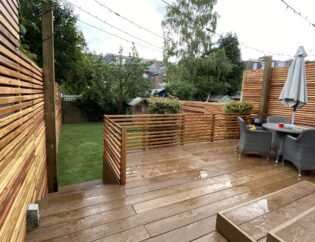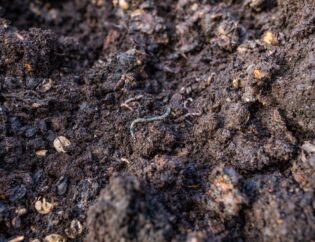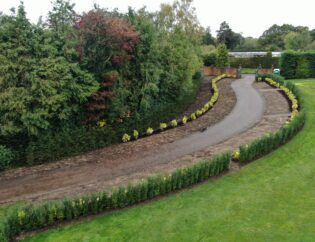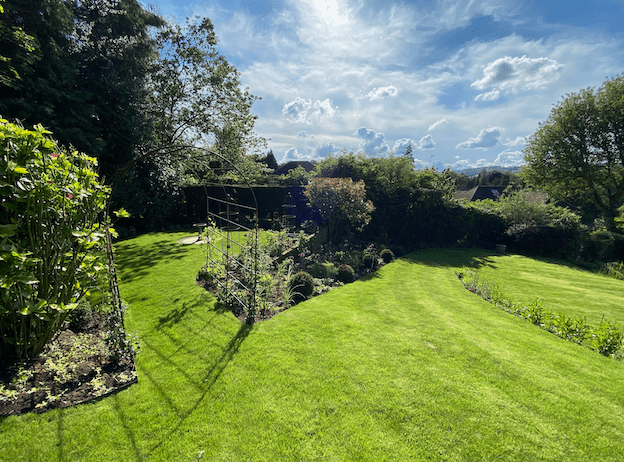
New Lawn Maintenance
Looking after your new lawn may feel a bit daunting, especially as the first few months after the turf has been laid are crucial to its health and longevity. However, with a few simple steps you can make a huge difference to the life of your lawn. In this post, Aye explains how to look after your new turf, and give it the best start so that it will remain healthy for many years to come.
Settling in: The first few weeks
A succulent green lawn is often the foundation of a garden design, and the excitement of a newly designed garden may tempt you to start using your grassed area straight away!
However, it is important to remember that your beautiful new lawn is made up of thousands of tiny plants, whose roots need to establish in their new soil. They need to be given the time to adjust to their new location and overcome the shock of being transplanted. So it’s important to avoid walking on your new lawn until the roots are established and the lawn firms up. If you have to walk on the lawn, wear flat shoes or place down boards on which to walk. This initial establishment period, where the roots will be penetrating the soil and the plants establishing themselves, depends on the nature of the soil. As a guide, this takes approximately 7-14 days during mild weather and 3-4 weeks during colder periods. During this time, the turf must not be allowed to dry out.

Watering
Watering your new lawn: Day One
Your newly laid turf will need moisture straight away to recover from being kept in a roll, to encourage new root growth and to keep the grass plants from dehydrating. This is especially important if the turn was laid on a hot or windy day. Once the turf has been laid, water your new lawn straight away ensuring that the soil underneath is damp to a depth of 100mm. Thereafter aim to keep the soil and turf damp. You can check this by lifting a corner of the turf. Care should be taken not to over-water the lawn. This initial watering is the only time that we recommended watering your turf in direct sunshine, as the need for moisture at this point is more important than the risk of scorching the leaves. At all other times, your grass should be watered in the shade, or early or late in the day, to prevent scorching
Watering your lawn: The following days
In the following days only water in the early morning or early evening so that the sun doesn’t burn off the water you have applied, or scorch the grass. You can water less and less frequently over the next 4 weeks. The turf should not be allowed to dry out or go brown in this period. As a guide, we suggest the following watering routine in the first few weeks.
- Week 1: Water twice a day in the summer (once a day in Spring)
- Weeks 2-3: Water 2-3 times a week
- After 3-6 weeks: You can drop down to watering once a week. It’s a careful balance –don’t allow the turf to dry out, but also don’t get to the point where the soil is sodden, because over-watering can be as much of a problem, especially on heavier soils. Until the roots get beyond the top 25mm of the ground, the sun and wind can play a big role in drying out the soil as well as the turf absorbing moisture. As you water, it will percolate down into the soil, eventually draining beyond the roots. Other plants, such as tree roots, will also be taking in water, and any turfed area beneath tree shade may need to be watered just as much as if it were in full sunshine
How much water?
It is difficult to recommend how much water your grass will need, as each lawn has different needs depending on a variety of factors such as location, shade, sun and type of soil. As a rule, you should not let your turf sit in water as this will lead to root rot. Watering can be done with a garden sprinkler, or if the area is large, you may wish to consider installing an irrigation system prior to laying the turf, as part of your garden project. The duration of watering should be in the region of 20-30 minutes as a rough guide, depending on the time of year. During the winter months, it should not be necessary to water. After a year, your new lawn will be well-rooted and watering can be done in times of drought
Mowing
Do not mow until your grass is established and well-rooted. The first mowing only needs to be a light “topping”, because the roots will still be establishing, and you want to avoid shocking the grass plants too much. If the grass is cut too low, the shock is too much for the plant and it will take longer to re-grow at any one mowing. Over time, you can gradually reduce the height of the cut. As a guide, domestic lawns should not be cut below 25mm in the summer; in a drought it is recommended to leave the height at 35mm and leave the cuttings rather than collecting them.
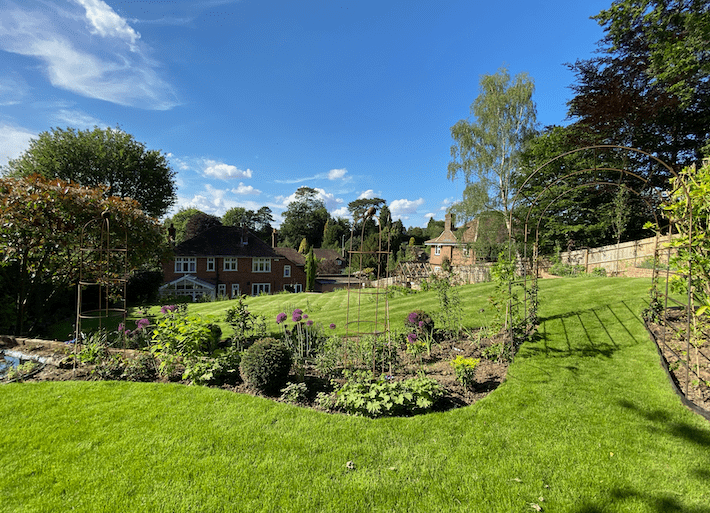
Fertilising
With a newly turfed lawn, it is important that you do not use any lawn treatment on it during the first 3-4 months of it being laid. When applying any lawn treatment, it is important that you follow the instructions –too much will burn the grass. After this settling in period, you can feed your lawn every 6-8 weeks during the growing season with a proprietary lawn fertiliser. We suggest starting this after at least 4 months, if the turf was laid in the summer, and after 2 months if laid in the spring
Aye's Trouble Shooting Tips
Rain forecast for the day your turf is laid? If it rains on the day that your turf is laid, still water your turf in – and any rain, even a short shower, will be an added bonus.
What kind of mower do I need? The best mower to buy is a cylinder mower. These have a nice cutting action, as opposed to a rotary motor that have more of a tearing action. Cylinder mowers are more expensive but are worth the investment.
Keep blades sharp! Whatever mower you decide to use, it is recommended that you have the blades sharpened at the start of the season. You should use a box to collect the grass clippings, except in drought condition.
For further advice on caring for your lawn, see our Lawn Care Calendar.


